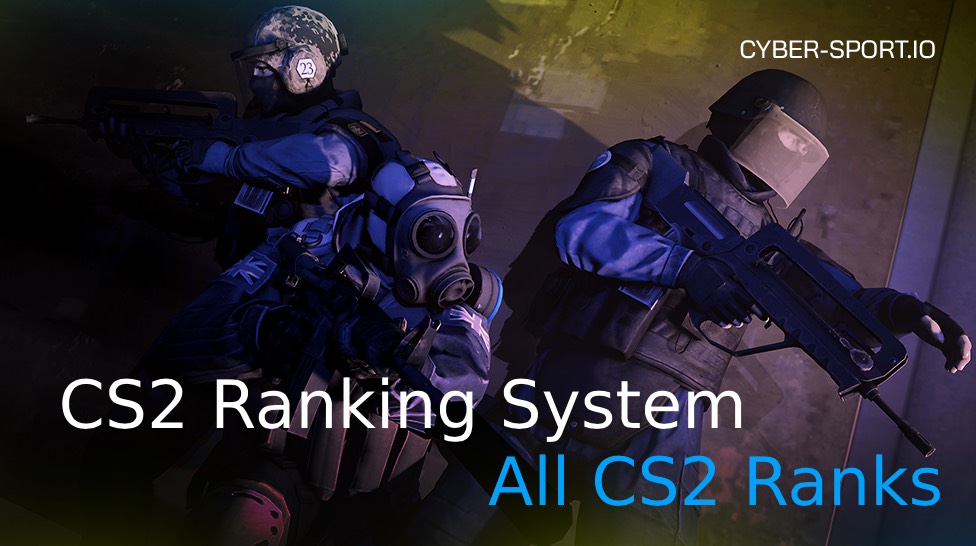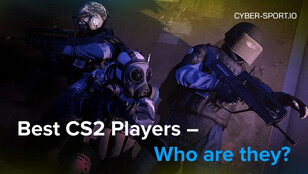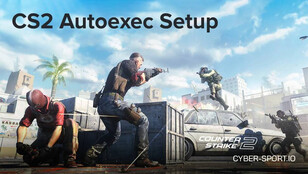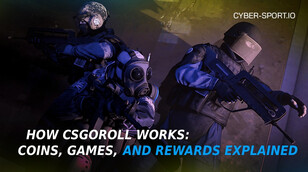What are the Ranks in CS2?
Competitive Ranks, the ones tied to individual maps, are as follows:
- Silver I (S1)
- Silver II (S2)
- Silver III (S3)
- Silver IV (S4)
- Silver Elite (SE)
- Silver Elite Master (SEM)
- Gold Nova I (G1)
- Gold Nova II (G2)
- Gold Nova III (G3)
- Gold Nova Master (GNM)
- Master Guardian I (MG1)
- Master Guardian II (MG2)
- Master Guardian Elite (MGE)
- Distinguished Master Guardian (DGM)
- Legendary Eagle (LE)
- Legendary Eagle Master (LEM)
- Supreme Master First Class (SM)
- The Global Elite (GE)
These ranks are primarily divided into four different tiers: Silver, Gold Nova (Golds), Master Guardian (MGs), and Top Four. It follows the classic CS rank system that veteran players know and love.
However, a new CS Rating is now tied with Premier games. These also have individual ranks but are represented with specific values instead of certain ranks. The Premier Ranks are:
- Grey: 4,999 and below
- Light Blue: 5,000 - 9,999
- Blue: 10,000 - 14,999
- Purple: 15,000 - 19,999
- Pink: 20,000 - 24,999
- Red 25,000 - 29,999
- Gold: 30,000 and above
CS Ratings are divided into seven different color-coded categories.
How Does The CS2 Ranking System Work?
Competitive Ranks follow the same classic ranking system previously used in CS:GO, starting from Silver I to Global Elite. However, it is now connected to the specific map you are playing on. This means that your rank on a specific map like Dust II doesn’t affect your rank on other maps. You’ll have to grind each map if you want them to be equally ranked. You’ll rank up after winning a certain amount of games. This number can vary depending on your performance and the ranks of other people in your lobby, but you’ll generally rank up after winning anywhere from 3-5 games.
The Competitive mode is made to be more of a “learning” or “training” mode that allows players to see how well they play on specific maps, instead of judging their overall CS2 skills.
This is where the Premier Ranks come in. CS2 introduced a CS Rating system that’s only available in Premier. It provides players with a specific value, reflecting their skill level. It starts at Gray for players with a CS Rating lower than 4,999 and goes up in 5,000 increments to the highest rank, Gold for the best players with more than 30,000 points.
At the start of every game, you’ll see how much CS Rating you’ll gain when you win or how much it will decrease when you lose. The game automatically calculates this at the start of each game and it won’t get affected even if you hard carry or get carried. To rank up, you’ll simply need to win enough games to get your CS Rating to meet the next tier.
CS2 Ranks Overview
While the CS Rating system and the old CS Ranks are very different from each other, players still try to compare the two. So, here’s a rough comparison of what your rank should be in Premier when translated to Competitive and vice versa.
- Gray (4,999 CS Rating and below) - Silver I to Silver Elite Master: These will generally be composed of newer players who are only trying out the game or playing it for fun.
- Light Blue (5,000 - 9,999) - Gold Nova I to Gold Nova Master: In this tier, players are starting to learn more about the game’s basic mechanics, throwing a couple of lineups, and maybe starting to learn about spray patterns.
- Blue (10,000 - 14,999) - Master Guardian I to Master Guardian Elite: This is where things get a bit serious. These players are starting to learn about the game’s advanced mechanics, from spray patterns to counter-strafing. You’ll also start to see more players aiming for the head, rather than the body.
- Purple (15,000 - 19,999) - Distinguished Master Guardian to Legendary Eagle: At this tier, the players with true skill start to shine. They’ll have solid mastery over movement and weapon mechanics, memorize lineups from the top of their heads, and start to know how to play off of their team.
- Pink (20,000 - 24,999) - Legendary Eagle Master to low Supreme Master First Class: These are the true grinders who play numerous hours per day, and can dink you across all ranges. They’ve mastered most of the game’s mechanics and analyze the game at a whole different level. There will also be a handful of streamers and pros popping up in your lobbies.
- Red (25,000 - 29,999) - Supreme Master First Class to low Global Elite: You’ll start seeing lobbies filled with pros and streamers within this range. They’ll wow you with their mechanics and know how to play with their team.
- Gold (30,000+) - Global Elite: These are the best of the best. It’ll mostly be composed of players who live and breathe CS such as the top professional players and the elite streamers.
Where Can I See Rank in CS2?
You’ll first have to “unlock” your rank by playing 10 placement games for whatever competitive game mode you’d like to see your rank for. In the case of Competitive Mode, you’ll have to play 10 games for each map to get your placement rank. For returning players, you’ll only have to win 1-2 games to reveal your rank.
Once you’ve completed your placement games, just follow these steps to view your rank:
- Open CS2 via Steam
- Click on the “Play” button
- Select “Matchmaking”
- Go to “Competitive” and you’ll see all of the maps, with their respective ranks underneath.
- Go to “Premier” and you’ll see your Premier Rank/ CS Rating under “Your Party” next to your player name.
Premier Ranks in CS2
As I’ve mentioned earlier, CS2 has introduced Premier Ranks which displays the exact value of your rating, leaving out all of the mysteriousness in older games. It’s based on the Elo system and follows a more modern way of tracking your skill level.
You can only participate in Premier mode matches if you have Prime Status enabled. Prime Status can be bought for a one-time purchase fee of $14.99. It unlocks bonus rewards and access to the coveted Premier competitive matchmaking.
Premier offers seven different groups, categorized by color, and separated by 5,000 CS Rating. Here are all of the Premier Ranks and the CS Rating required to get promoted.
- Grey: 4,999 and below
- Light Blue: 5,000 - 9,999
- Blue: 10,000 - 14,999
- Purple: 15,000 - 19,999
- Pink: 20,000 - 24,999
- Red 25,000 - 29,999
- Gold: 30,000 and above
Valve made it very simple for players to rank up. At the start of each game, you’ll see how much CS Rating you’ll gain or lose depending on the outcome of the match. This is determined by a secret formula that is pretty vague. However, most people believe that it’s tied to your current CS Rating, the CS Rating of people within your lobby, and your past performances. Basically, if you’re going against lower-rated players, CS2 thinks you should easily win and will reward you with less rating for winning and penalize you for more points when you lose. Overall, the CS Rating you get for that specific game won’t change no matter how bad or good you perform and will solely be dictated by winning or losing the match.
Premier closely mimics how the professionals play the game. You start off with banning/picking phases for the map, along with a team picking their starting side. It also shows some relevant data for your team’s and the enemy team’s past map picks, allowing you to plan your bans ahead of time.
I personally think it’s a better way to play the game, and makes you feel like you’re always playing at an elite level, even if you’re a low-rated player. It also eliminates the guesswork that was present in the previous ranking system since you’ll always be aware of the CS Rating that’s at stake.
How To Rank Up Fast in CS2?
I know how hard it is to grind the ranks and climb the ladder. So, I’ve gathered a couple of tips that helped me rank up fast in CS2. Hopefully, I can help you out as well.
Learn Lineups
I know how boring lineups can be, but it’s an essential mechanic that you’ll need if you want to reach higher ranks. Eyeballing and openly throwing grenades can only take you so far. Knowing where each of your grenades will land and what they will cover/hit can help you plan ahead and strategize with your team.
You can cover commonly played angles with smoke lineups, allowing for an easier time when entering the site. You can also use molly or grenade lineups to defend sites from a safe distance. Lineups are also useful when selling a fake, forcing your enemies to rotate and leave one side of the map defenseless. Always have a couple of lineups in your bag for each map. It’s a bore and it takes some practice, but I promise you, it’s worth it and you can use it no matter what elo you play in.
Warm Up Before You Queue Up
An often overlooked aspect is warming up your aim. Some players think it’s useless, others simply don’t want to fire up Aim Labs or hit a DM or two. However, it’s truly helpful to warm not only your aim but also your mindset before playing a ranked game.
Personally, I’m guilty of not warming up during my earlier days. I always queued up directly into rank games and ended up whiffing, getting tilted, and losing most of my games. Warming up not only helps you get into the flow but also dictates how the rest of your gaming session will play out.
Play With Friends
Finally, I think the most effective strategy I used to help me rank up was simply playing with friends. Typically, I’d suggest having at two other people to team up with if you can’t find a full team. Playing with friends ensures that you’re on the same page with a majority of your team and is a huge help when strategizing and planning out rounds.
I also highly suggest jumping into a Discord server to prioritize comms with your friends. It can also improve your mental and reduce tilt scenarios, laughing up mistakes but also discussing them with your friends. Another benefit is that you’ll have a better feel of each others’ playstyle, while also having someone you can surely depend on in the lobby.
CS2 Ranks Per Map
The old CS ranking system lives within the Competitive game mode. However, unlike before where players get a single rank across all maps in the pool, CS2 ties specific ranks to each map. It still follows the same Silver I to Global Elite hierarchy levels.
Honestly, I think it’s better to use Competitive mode as a training ground. It serves as a tool for players to improve their map knowledge and other map-based skills. You can find weak spots within your game, explore different maps you don’t often play in Premier, and just grind your way up to Global Elite in all of the maps. That might just be the biggest flex now in CS2, especially considering how much time it would take to grind a single map to Global Elite, now imagine being that good at all of them. Dreaming aside, it’s one of the best ways to test and train your skills for specific maps.
FACEIT Ranks in CS2
If you aren’t familiar with it, FACEIT is a third-party platform that provides matchmaking services for CS2. It features better servers, better players, better anti-cheat, and an overall better competitive environment. Games played via FACEIT are typically high-skill and high-intensity, allowing good players to push themselves to the limit by constantly challenging good players. There are a total of 11 FACEIT ranks, linked directly to a player’s Elo rating.
- Level 1: 100-500
- Level 2: 501-750
- Level 3: 751-900
- Level 4: 901-1050
- Level 5: 1051-1200
- Level 6: 1201-1350
- Level 7: 1351-1530
- Level 8: 1531-1750
- Level 9: 1751-2000
- Level 10: 2001+
- Challenger: Top 1,000 players at level 10
FACEIT matches are brutal as most players take it very seriously. It brings a whole new level of competition to CS2, so I don’t recommend it for the faint of heart. Honestly, I don’t think it’s an environment you’d want to be in if you are a beginner or low-ranked player. I’d start considering FACEIT around DMG or Purple in Premier, but only if you want to get better and push yourself.
Conclusion
That’s everything you need to know about the CS2 Ranking system and all of the different CS2 ranks. Climbing the ranks takes a lot of patience and determination. You’ll have to dedicate time not only in playing the game, but practicing it across all aspects. If you just continue grinding, I’m sure you’ll get your dream rank in no time.
FAQ
How To Increase My CS2 Rank?
In Premier, you’ll have to earn enough CS Rating to meet the next rank threshold. In Competitive, there’s a bit more guesswork involved, but after winning a handful of games in a row, you’ll be eligible for promotion. At the end of the day, it all boils down to winning games.
What is the Best CS2 Rank?
Global Elite is the highest rank if you’re playing Competitive mode or following the old ranking system. However, the Gold division is the highest in Premier, requiring at least 30,000 CS Rating to attain it.
What is S1 in CS2?
S1 is an abbreviation for Silver 1. These abbreviations actually climb up the ladder and usually, you just take the first letter of the rank and its number. For example, Gold Nova III is typically called G3, and Global Elite is simply GE.
How Do CS2 Premier Ranks Work?
Premier Ranks in CS2 follow an Elo point system where you’re rewarded or penalized a specific amount of points for winning or losing a game. Honestly, it’s as simple as that. You rank up once you reach the next division’s threshold, and get demoted when your CS Rating is no longer suitable for your current rank.
How To Rank Up Easy in CS2?
Practicing and honing your game are the obvious ways to rank up. To get better, you’ll have to be better, right? But if you were to ask me, one of the easiest ways to rank up is to simply play with friends. It eliminates a ton of the uncertainties with random lobbies and can also make the game more fun to play. It won’t take you from S2 to DMG, but it’ll make climbing more fun and tolerable.
CS2 Gambling
CS2 Skin Trading
Rust Gambling
Promo Codes
Online Casinos
Crypto Casinos
CyberSport Feed










![CS2 Rank Distribution in [year] CS2 Rank Distribution in [year]](/imgs/news_7959/20241011/cache/1728647520_6b5a528dc8c6fd1dcfb1___308_174.jpg)
